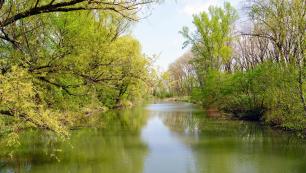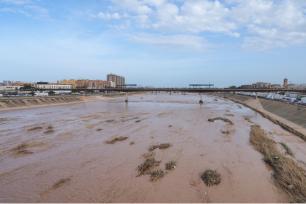
Making cities more resilient to extreme climate phenomena is a complex challenge and there is no single answer, but nature must certainly be integrated; doing it with a scientific basis can help a lot.
The devastating consequences of DANA, which has particularly affected Valencia, highlight how important it is to rethink cities to adapt them to future torrential rains. We talk about it with CREAF researcher Mariona Ferrandiz, also a professor at the Universitat Autònoma de Barcelona (UAB) and co-creator of the Replantegem project, and CREAF researcher Annelies Broekman, specialized in water and global change, who insist on the use of Nature-Based Solutions (NBS) such as rain gardens, and avoid concrete to minimize future impacts on urban areas. Likewise, they both propose some criteria that must be considered now that the reconstruction of the affected localities and the surrounding areas is starting.
"Making cities more resilient to extreme climate phenomena is a complex challenge and there is no single answer, but nature must certainly be integrated; doing it with a scientific basis can help a lot", explains Mariona Ferrandiz. Beyond the urban areas, the entire basin must also be analysed with perspective, "since a stream can flood a population that is located many kilometres away and, therefore, it is also important to apply measures on a landscape scale”, adds Annelies Broekman.

River with riparian forest. Public domain image
Less cement, more green and drainage
One of the measures to adapt cities is to create more green spaces in the city, such as parks, gardens or urban forests. The reason is that the soil in green areas is porous and acts like a sponge capable of absorbing water when it rains; also, the roots of trees and shrubs help to retain it. On the other hand, cement is impermeable and therefore does not retain water when it rains, which accumulates and circulates much more quickly. According to Ferrandiz, "the greener infrastructure there is, the more the risk of flooding streets and buildings is minimized". Regarding the choice of species to plant, priority must be given to trees and plants that are adapted to local conditions and that have more resistance to extreme climatic conditions.
Another action to keep in mind is to implement sustainable drainage systems (SUDs). For example, there are pavements that imitate "natural soil" and are permeable. You can also build cobblestones interspersed with vegetation or concrete blocks with spaces that help reduce the volume of water. Another example focused on water are the 'rain gardens', constructions in the middle of the city that have a slight depression with plants and that are filled with water when it rains; these gardens are made up of plant species resistant to both drought and excess water. Another case of SUDs are urban wetlands, areas flooded in a controlled way where aquatic plants are used to filter runoff water when it rains, plant vegetation on the sides of streets or promote green roofs to channel and filter the rain.
As for the areas next to the rivers that flow through the city, it is necessary to plant trees that can take deep roots and that are stable when there are high water flows. In this case, a good option is the species typical of the riparian forest, such as poplar, hazel or elder.
As for the areas next to the rivers that flow through the city, it is necessary to plant trees that can take deep roots and that are stable when there are high water flows. In this case, a good option is the species typical of the riparian forest, such as poplar, hazel or elder. It is also advisable to plant vegetation where there may be a risk of landslides, as their roots help to compact the soil and prevent it from eroding.
With respect to coastal areas, the dunes must also be recovered and native vegetation planted to help them consolidate, "in this way, if there is a storm, the water will be able to infiltrate and act as a natural containment barrier”, explains Annelies Broekman. A case of success has been set in motion by Malgrat de Mar (Catalonia, Spain), which in 2001 began to revegetate with psammophilous on the Conca beach and proposes a gradual process of renaturation of the sections of promenade repeatedly affected by storms.
A living basin
Apart from these proposals, more focused on the cities, the entire hydrographic basin must also be analysed and bet on renaturalizing it with criteria for adaptation to the climate crisis and which can mitigate flooding and reduce the risk of water reaching the population. For example, some of the solutions include improving the condition of riparian forests, which live on the banks of rivers, or creating avenue lamination spaces - floodable areas next to the river - so that water is diverted there if there is torrential rain, respect old ravines and do not waterproof them, restore deltas and wetlands and also carry out adaptive forest management at the headwaters of the river, "because they fulfil their water regulation function". It is also necessary to assess which activities the soil is intended for - agriculture, tourism, urban planning or industry - and opt for more adaptive models, such as regenerative agriculture, which recovers the health of the soil and therefore its ability to retain water. In short, "preventing floods goes beyond managing water, you must also manage land use", warns Annelies Broekman.
Restoring streams and rivers is also important to curb floods and possible overflows. In this case, always bearing in mind that canalization and containment dams must be avoided as much as possible, "which also give a false sense of security, and when there is a flood, the water stagnates and cannot back to the river", explains Broekman. Instead, a living and dynamic river must be maintained, which can create meanders – bends during the river – that make the water must travel a longer distance and zigzagging, which decreases its speed, it allows the space to drain progressively and prevents too much water from being concentrated in the same area. "In addition, biodiversity must also be encouraged, as the vegetation also acts as a sponge that absorbs water, helps to keep the soil compact thanks to its roots and retains sediments", points out Mariona Ferrandiz.
Another critical point is to halt and review new infrastructure projects that are close to flood zones, such as the coast, rivers or streams, because although measures can be taken to minimize overflows, the risk cannot be eliminated.

Turia River Canal after DANA in Valencia. Public domain image
Rebuild judiciously
Starting to rebuild the affected areas is a challenge, but it must be done with adaptation in mind, because these storms in these areas will become increasingly frequent and virulent. It must be done with a new perspective and must always be accompanied by scientific criteria. "The first step is not to fall into the same mistakes, starting to rebuild things as they were before the flood. We also need to change rebuilding protocols, as rebuilding aids must be used within a few months and we can fall into rapid rebuilding that repeats the patterns that have already led to the devastating effects of DANA. For this reason, the experts recommend taking time to assess whether the buildings that have been destroyed are still necessary or not, in case some space can be naturalized, and to study the environmental impact of the new buildings and their resilience, especially since from the point of view of adaptation, "because they can be areas where flooding will happen again in the future", warns Broekman. Both experts agree that another fundamental piece is to work and listen to the community to design these new spaces, on the one hand, to increase awareness of the benefits of nature-based solutions and, on the other hand, to consider their needs.
In this sense, it is always positive to be inspired by places and projects where solutions are already being implemented that we can learn from. For example, in Sant Boi del Llobregat, some space is being co-designed for water retention through the Sant Boi Respira + Verd initiative, with the participation of CREAF. Also, in the CARDIMED European project, of which CREAF is a partner, research is being carried out to prevent floods in the Italian city of Catania, which has a double challenge: taking advantage of water in times of extreme drought and also avoiding floods by increasingly frequent torrential rains. "A rain garden is being built there that helps absorb water when it rains and, at the same time, fill the aquifers," explains Ferrandiz. Beyond this project, the city of Rotterdam in the Netherlands has also started to redesign the city and make it flood-proof.
"We must bet on making landscapes more resilient, transform the territory and minimize the risk. To do this, nature is key", they conclude.

